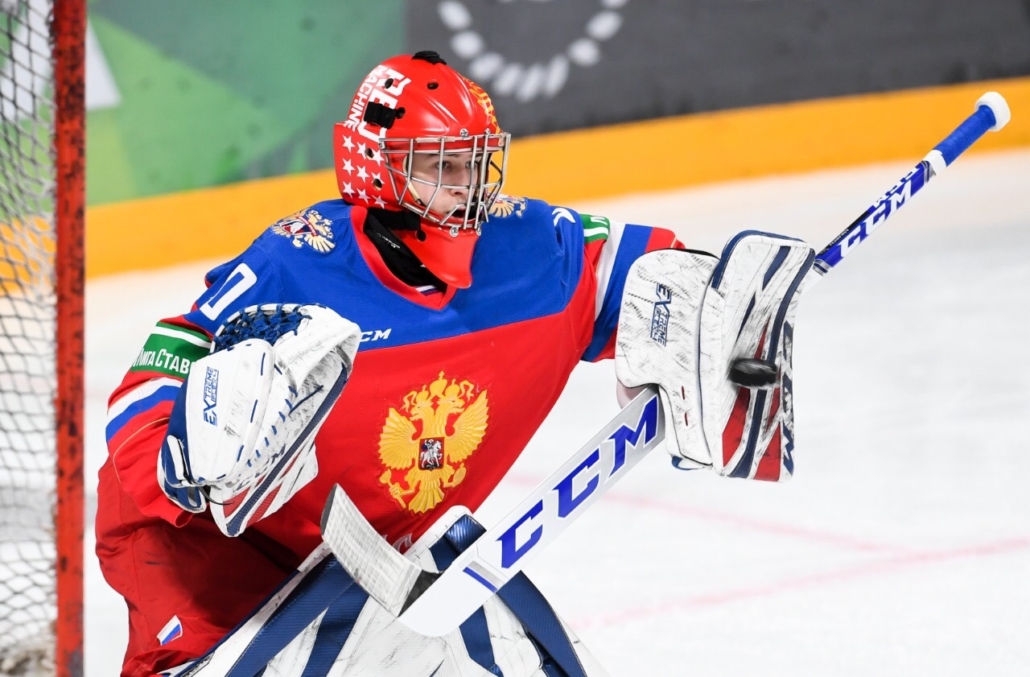Steve Kournianos | 4/27/2020 | Nashville | [hupso]
Profile
Position: Goalie
Catches: Right
Height / Weight: 6’3, 176 lbs
Born: June 16th, 2002 | Omsk, Russia
Nation: Russia
The Draft Analyst Ranking:
| PRE | AUG | DEC | JAN | MAR | APR |
|---|---|---|---|---|---|
| 24 | 18 | 11 | 10 | 18 | 18 |
Regular Season
| Season | Team | GP | W | L | SOL | GA | S | Sv | SV% | GAA | SO | TOI |
| 2017-18 | Russia (U17 5N-APR) | 2 | 2 | 0 | 0 | 4 | — | — | — | 2.00 | 0 | 120:00:00 |
| 2018-19 | Russia (U18 Hlinka) | 4 | 3 | 1 | 0 | 9 | 103 | 94 | 0.913 | 2.26 | 1 | 239:47:00 |
| 2018-19 | Russia (WU17HC) | 5 | 5 | 0 | 0 | 7 | 135 | 128 | 0.948 | 1.40 | 2 | 300:00:00 |
| 2018-19 | Russia (WJAC) | 4 | 3 | 1 | 0 | 5 | 108 | 103 | 0.954 | 1.26 | 1 | 238:00:00 |
| 2018-19 | SKA-Varyagi (MHL) | 31 | 15 | 12 | 4 | 68 | 864 | 796 | 0.921 | 2.37 | 4 | 1724:30:00 |
| 2018-19 | Russia (U18 WC) | 6 | 3 | 2 | 1 | 14 | 167 | 153 | 0.916 | 2.31 | 1 | 363:47:00 |
| 2019-20 | Russia (U18 Hlinka) | 4 | 4 | 0 | 0 | 5 | 124 | 119 | 0.959 | 1.25 | 1 | 240:00:00 |
| 2019-20 | Russia (U20 4N-NOV) | 3 | 2 | 0 | 0 | 4 | 61 | 57 | 0.938 | 2.28 | 0 | 130:45:00 |
| 2019-20 | Russia (U20 WJC) | 5 | 2 | 1 | 0 | 10 | 81 | 71 | 0.877 | 2.71 | 0 | 221:00:00 |
| 2019-20 | Russia (U18 5N-FEB) | 3 | 2 | 1 | 0 | 7 | 76 | 69 | 0.908 | 2.28 | 0 | 183:13:00 |
| 2019-20 | SKA-Neva (VHL) | 18 | 12 | 3 | 3 | 43 | 536 | 493 | 0.920 | 2.45 | 1 | 1052:30:00 |
| 2019-20 | SKA (KHL) | 1 | 1 | 0 | 0 | 2 | 0.920 | 2.00 | 0 | 60:00:00 |
Season Review
It began as a season for the ages for the 17-year-old backstop, who in August won gold for Russia by stonewalling one of the strongest Canadian entries in recent memory at the under-18 Ivan Hlinka Memorial Cup. And if last year’s ridiculous medal run as a 16-year-old wasn’t enough to convince his critics how special a talent he was, then his record-setting .959 save percentage in three games (including 35 of 37 stops in the gold-medal match) should have done the job to reality-check the few nonbelievers. All this before the season even started.
Askarov joined SKA-Neva in the adult-age VHL shortly thereafter and quickly established himself a regular. His coach took an obvious liking to Askarov and rewarded him with multiple starts against some of the league’s top adult-age attacks. He eventually became the youngest goalie in VHL history to appear in more than nine games, finishing with an impressive 12-3-3 mark while splitting duties with 1998-born Alexei Melnichuk. In November, Askarov became the youngest goalie in KHL history to record a win by posting a 23-save effort against Sochi. As if he needed another feather in his cap, Askarov went out and dominated the U20 Four Nations against national teams loaded with eventual participants for the World Juniors.
It was in late December at the World Junior Championship in Ostrava, Czech Republic when things for Askarov took a sharp turn. A pair of leaky performances against the host Czechs followed by Sweden highlighted an otherwise successful tournament for the Russians themselves, as they won silver with Askarov a backup for the gold-medal game. A month later, his performance at the February U18 Five Nations may not have been Askarov-like by his standards, but he still won two of his three starts, including a win over Czechs where he thwarted all five shootout attempts. As inconsistent as Askarov was at the world juniors, he went on and finished the season with a career international record of 30-6-1 along with a staggering .932 save percentage.
Suboptimal WJC performance notwithstanding, the only potential issue from Askarov’s season is the fact that he started only two VHL games in the nearly three months thereafter. No reports were given regarding a potential injury, and a benching should be ruled out since Askarov had already beaten top VHL teams. Still, it’s reasonable to speculate that Askarov’s advisors may have coddled for almost the entire second half season in order to limit his in-game experiences to only practices and film-room sessions.
Style
Askarov uses a hybrid style similar to Patrick Roy — a total vertical stance that explodes into an airtight butterfly. A noteworthy aspect of Askarov’s style is constant movement, which is imperative to properly defend the upper half (stand-up) and dominate the lower half (butterfly). Askarov’s superior flexibility, athleticism, and quickness (and proper stick positioning) are all on display during most possessions inside his own end. Viewing him as being “jittery” or having “happy feet” without understanding Askarov’s style and how it clearly works for him sets critics up for failure — Askarov is incredibly intelligent and possesses technical superiority in multiple areas that validate a style that not only works best for him but also has given him a proven track record in both league and tournament play.
Post Integration
Askarov mostly uses a Reverse Vertical-Horizontal (RVH) with his skate blade on the post and stick blade perfectly horizontal to the ice. It’s possible he’s used an overlap or toe-lock when in the RVH, but the majority of his games reveal positioning with his skate perfectly wedged into that near post. Askarov uses the post to execute powerful lateral pushes and rarely gets beaten on wraparounds or short-side snipes. On occasion, Askarov will either lose the net slightly or overcommit from a strong post-to-post push, thus leaving him vulnerable to short-side or upper-half snipes; even if he’s playing his angles properly.
Still, Askarov’s footwork and movements result in snap post-leans that come across as surgical the more you watch him. When it comes to sealing off as much of the post as he can, Askarov generally has the lower half covered like a blanket. He does leave room upstairs on occasion; possibly gambling on a shooter’s inability to elevate. Straightening up and tilting his head a tad to address short-side high while in the RVH is easier said than done, but Askarov’s save percentage from chances below the circles must be astronomical.
Glove and Blocker
Askarov’s high-glove positioning has been scrutinized ad nauseam since his opening-round loss to the Czechs at the World Juniors. The problem with the criticism is that it didn’t exist until a two-game sample size against the top under-20 talent in the world. From a technical standpoint, there is nothing wrong with where or how Askarov positions it. His palm is outward facing the upward trajectory of the puck rather than cupping or yo-yo’ing. The fact that he holds it high simply means that he’s comfortable keeping it that way. That same glove hand didn’t seem to be a problem when he was stonewalling Canada’s potent attack at the Hlinka, or in a 40-save shutout of the VHL’s No. 2-ranked team. Thus, the idea that Askarov’s glove hand is a “red flag” based on two games is beyond preposterous. Especially when all it takes is a slight adjustment to his angle (which comes with age and experience) as well as familiarity with opposing shooters to render the concern irrelevant. As far as his blocker, Askarov’s uses it effectively by timing the turn of his wrist perfectly to turn pucks into the corner with authority.
Reads and Tracking
Askarov has phenomenal hockey IQ and reads plays a good two to three seconds before they develop. In a goalie’s case, that involves locking in on puck movement in addition to identifying potential threats and communicating instructions to his teammates in coverage. Askarov does this better than any goalie in his class and his acute vision and sixth sense for a 17-year-old goalie are equally as impressive as 2019 first-round pick Spencer Knight. Askarov locks his head with his shoulders and feet into one movement to remain square to the puck with a direct line of sight to the shooter. You rarely see him react late or out of position from seam passes that lead to one-timers, and being tall, upright and active helps him follow d-to-d passes and shots from the points.
Rebound Control and Post-Save Recovery
Askarov usually stays within the blue paint and will challenge shooters above the crease on occasion. He does put a fair amount of rebounds back into the slot and also out of stick reach, specifically on high-danger chances. But he also gobbles up most of the shots he faces and generally keeps the rebounds close enough to gobble up before a second-chance opportunity can materialize.
Quickness and Footwork
Possibly the most impressive aspect of Askarov’s skillset outside of his IQ is his cat-like quickness and the dynamism of his push. He also uses well-timed shuffles and can execute multiple iterations to adjust his angle before a shooter is at his release point. Askarov’s backside push into an RVH is textbook, even if he’s dealing with traffic or getting bumped out of his crease.
Puck Handling/Stickwork
Askarov is not consistently active on dump-ins like a Martin Brodeur or a Mike Smith but he is more than comfortable and capable at handling the puck. He can deliver an accurate stretch pass to catch opponents in a line change and also intercepts hard-arounds, but for the most part he stays in his crease and allows his defenders to retrieve without confusion. Of course, there have been instances of miscommunication (like all goalies), but Askarov for the most part is above average in his ability to clear pucks out of harm’s way and connect with a tape-to-tape pass.
Endurance
Askarov may seem like he’s always in motion, but his movements and positioning are based off necessary reads. You would think a goalie who is as active in the crease as Askarov would tire out easily, but he seems to be in outstanding shape. This helps him look more fluid and compact with his movements as the game progresses. Askarov has a high motor and can deal with multiple mad scrambles near his crease without tiring. His workload in the VHL was limited since he was mostly an understudy but his ability to sting together three or four consecutive outstanding performances within a compacted schedule of short tournament proves he has potential for sustained success under grueling conditions.
Goalies can have a high hockey IQ as well. Not talked about enough. As long as a goalie makes the read like Askarov does at 0:10, it would take a near-impossible sick move from a McDavid or Pettersson to score from that close.
He outfoxed the shooter before the shooter knew it pic.twitter.com/8XYWm5iSKP
— Steve Kournianos (@TheDraftAnalyst) April 28, 2020



